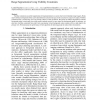Free Online Productivity Tools
i2Speak
i2Symbol
i2OCR
iTex2Img
iWeb2Print
iWeb2Shot
i2Type
iPdf2Split
iPdf2Merge
i2Bopomofo
i2Arabic
i2Style
i2Image
i2PDF
iLatex2Rtf
Sci2ools
IJCV
2002
2002
Range Segmentation Using Visibility Constraints
Visibility constraints can aid the segmentation of foreground objects in a scene observed with multiple range imagers. Points may be labeled as foreground if they can be determined to occlude some space in the scene that we expect to be empty. Visibility constraints from a second range view can provide evidence of such occlusions. We present an efficient algorithm to estimate foreground points in each range view using explicit epipolar search. In cases where the background pattern is stationary, we show how visibility constraints from other views can generate virtual background values at points with no valid depth in the primary view. We demonstrate the performance of both algorithms for detecting people in indoor office environments.
Related Content
| Added | 22 Dec 2010 |
| Updated | 22 Dec 2010 |
| Type | Journal |
| Year | 2002 |
| Where | IJCV |
| Authors | Leonid Taycher, Trevor Darrell |
Comments (0)

